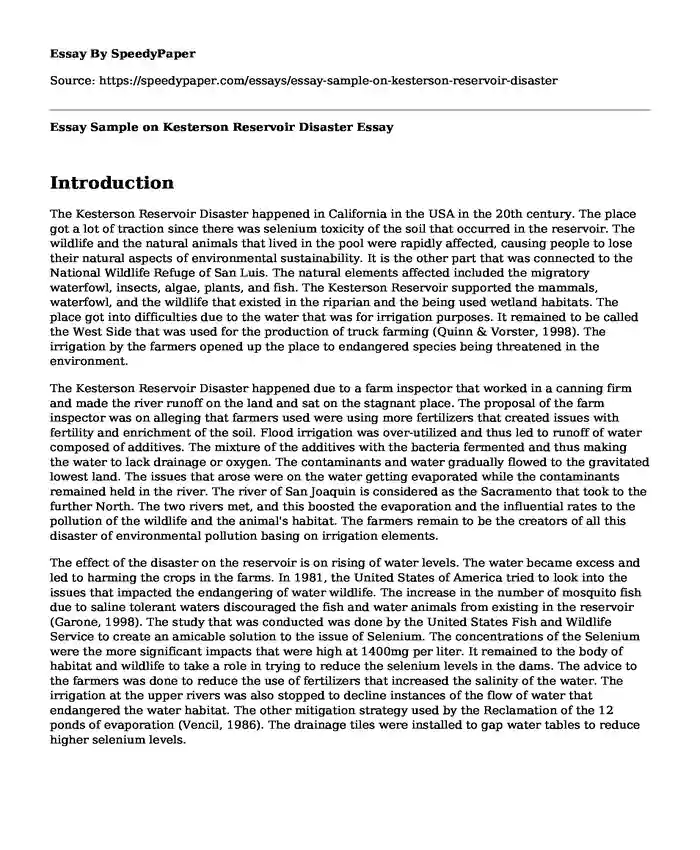Introduction
The Kesterson Reservoir Disaster happened in California in the USA in the 20th century. The place got a lot of traction since there was selenium toxicity of the soil that occurred in the reservoir. The wildlife and the natural animals that lived in the pool were rapidly affected, causing people to lose their natural aspects of environmental sustainability. It is the other part that was connected to the National Wildlife Refuge of San Luis. The natural elements affected included the migratory waterfowl, insects, algae, plants, and fish. The Kesterson Reservoir supported the mammals, waterfowl, and the wildlife that existed in the riparian and the being used wetland habitats. The place got into difficulties due to the water that was for irrigation purposes. It remained to be called the West Side that was used for the production of truck farming (Quinn & Vorster, 1998). The irrigation by the farmers opened up the place to endangered species being threatened in the environment.
The Kesterson Reservoir Disaster happened due to a farm inspector that worked in a canning firm and made the river runoff on the land and sat on the stagnant place. The proposal of the farm inspector was on alleging that farmers used were using more fertilizers that created issues with fertility and enrichment of the soil. Flood irrigation was over-utilized and thus led to runoff of water composed of additives. The mixture of the additives with the bacteria fermented and thus making the water to lack drainage or oxygen. The contaminants and water gradually flowed to the gravitated lowest land. The issues that arose were on the water getting evaporated while the contaminants remained held in the river. The river of San Joaquin is considered as the Sacramento that took to the further North. The two rivers met, and this boosted the evaporation and the influential rates to the pollution of the wildlife and the animal's habitat. The farmers remain to be the creators of all this disaster of environmental pollution basing on irrigation elements.
The effect of the disaster on the reservoir is on rising of water levels. The water became excess and led to harming the crops in the farms. In 1981, the United States of America tried to look into the issues that impacted the endangering of water wildlife. The increase in the number of mosquito fish due to saline tolerant waters discouraged the fish and water animals from existing in the reservoir (Garone, 1998). The study that was conducted was done by the United States Fish and Wildlife Service to create an amicable solution to the issue of Selenium. The concentrations of the Selenium were the more significant impacts that were high at 1400mg per liter. It remained to the body of habitat and wildlife to take a role in trying to reduce the selenium levels in the dams. The advice to the farmers was done to reduce the use of fertilizers that increased the salinity of the water. The irrigation at the upper rivers was also stopped to decline instances of the flow of water that endangered the water habitat. The other mitigation strategy used by the Reclamation of the 12 ponds of evaporation (Vencil, 1986). The drainage tiles were installed to gap water tables to reduce higher selenium levels.
Conclusion
In summary, the Kesterson Reservoir Disaster was caused by irrigation and also the issues of the use of more fertilizers. The waterfowl, fish, and mammals were differently impacted, and this created a lot of challenges that were difficult to cap - the use of water tiles and the evaporation bonds aid in reducing the impacts of disaster. The water animals and the wildlife habitat were reduced through a rise in Selenium levels. The environment remains to be the most significant habitat for more convenience to be well stipulated in the natural world we live in today.
References
Quinn, N. W., & Vorster, P. T. (1998). The role of science in the resolution of environmental crises at Kesterson Reservoir and Mono Lake, California. Lakes & Reservoirs: Research & Management, 3(34), 187-191.
Garone, P. (1998). The tragedy at Kesterson Reservoir: a case study in environmental history and a lesson in ecological complexity. Environs: Envtl. L. & Poly J., 22, 107.
Vencil, B. (1986). The Migratory Bird Treaty Act-Protecting wildlife on our national refuges-California's Kesterson Reservoir, a case in point. Natural Resources Journal, 26(3), 609-627.
Cite this page
Essay Sample on Kesterson Reservoir Disaster. (2023, Apr 01). Retrieved from https://speedypaper.net/essays/essay-sample-on-kesterson-reservoir-disaster
Request Removal
If you are the original author of this essay and no longer wish to have it published on the SpeedyPaper website, please click below to request its removal:
- Youth and Society, Free Essay with an Article Summary
- Free Essay Sample: Associates in Avionics Technology
- Free Essay: System Background and Functionality of the New Print-R-Us Automated System
- Comparison Essay Sample: Human Rights Administrative Bodies in the EU Compared to the US
- Reflection on Bay Food Company, Free Essay in Strategic Management
- Essay Sample: Ethnography in the Moonstruck Movie
- Pop Culture: A Trend Among the Youths
Popular categories





